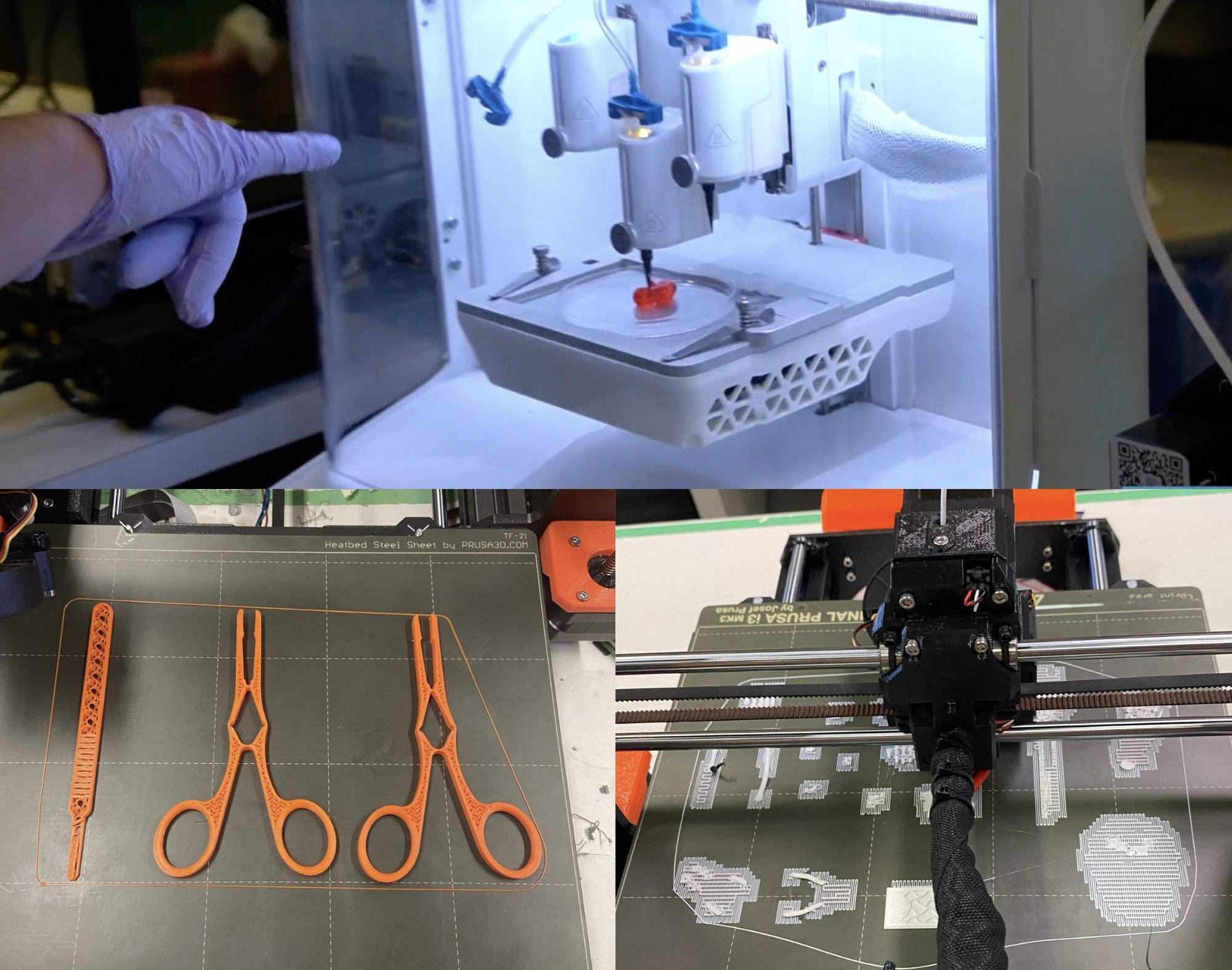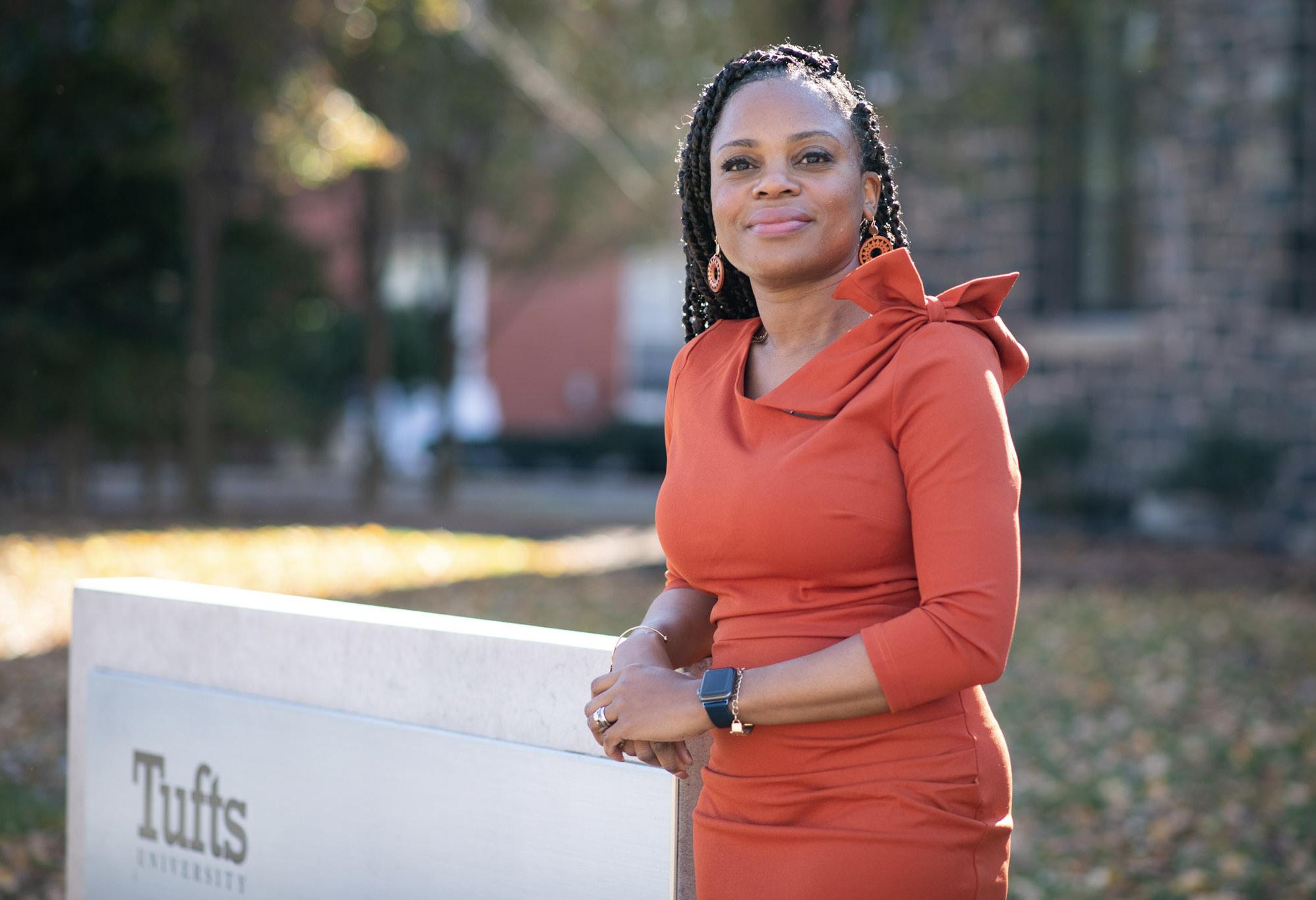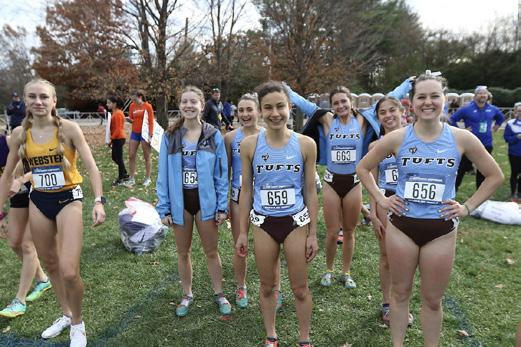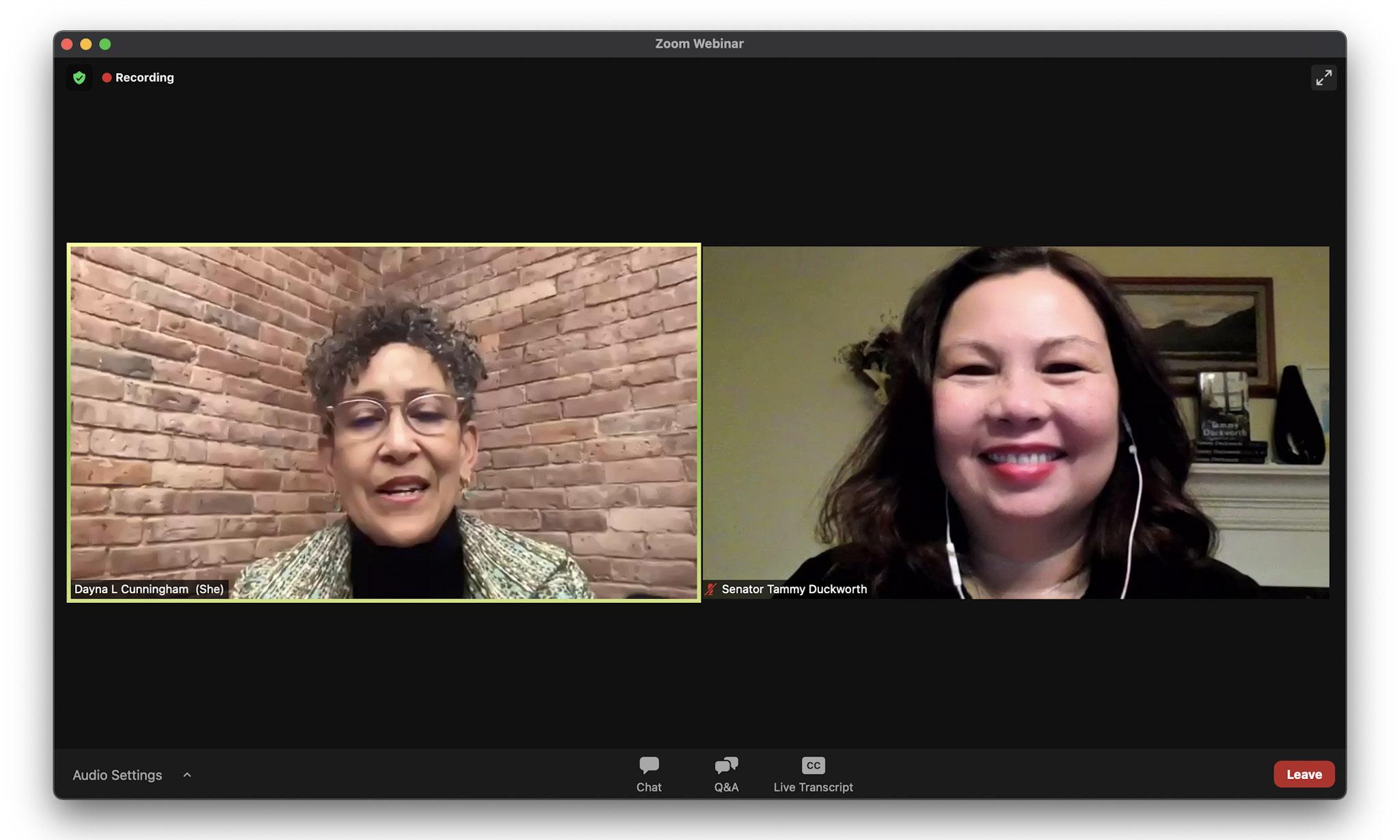
18 minute read
NEWS
THE TUFTS DAILY
VOLUME LXXXI, ISSUE 37 MEDFORD/SOMERVILLE, MASS.
Advertisement
Tuesday, November 30, 2021
tuftsdaily.com
SCIENCE 3D-printing class pushes students to frontier of modern medicine
by Avery Hanna
Contributing Writer
Among the 3D printers throughout the room, Vincent Fitzpatrick, a postdoctoral biomedical researcher at Tufts University, holds up a gray unassuming piece of plastic, crisscrossed with a cage-like structure. Hidden beneath a series of support structures that have yet to be removed, he explains, lies a perfect replica of a patient’s bone — assembled from data isolated from a CT scan so that it would have a Cinderella-like fit if surgically implanted.
This is just one of the many models throughout the room that students in 3D Printing the Human Body — a new course in the biomedical engineering department — have created, and it represents just one way 3D printing has revolutionized and continues to redefine modern medicine.
Fitzpatrick decided to teach the class when he noticed the lack of classes available for students interested in 3D printing.
“The idea of the class is to cover as wide a range as possible
WILL FLAMM / THE TUFTS DAILY, COURTESY MICHELLE MA A working 3D printer, 3D-printed tweezers and several skeletal models are pictured. of new technologies and applications of 3D printing in the medical field,” Fitzpatrick said. What makes the course unique is the opportunity for hands-on work with a variety of bioprinters. Self-described “3D-printer-guy” Riley Patten, a teaching assistant for the class and a member of the Kaplan Lab, where Fitzpatrick also works, said the value of the course comes primarily from the 3D printing experience.
“I remember it was always very scary to look at a 3D printer or a bioprinter and be like, ‘Well I have no idea how that works; I’ll do something else,’” Patten, a senior, said. “I think the goal is getting people comfortable looking at them and using them.”
Because it’s the first year the class has run, Fitzpatrick has had to adapt the course as it unfolds. Though he initially expected moderate interest that would lead to a small class of between 10–15 students, he wound up with over 30. Patten said this presented additional challenges.
“3D printing is a lot of sitting down next to each other and trying to figure out why [things] didn’t work,” Patten said. “It’s tough with a lot of people. We didn’t have that experience going in, but we’re figuring it out, and each week, we have a set plan of what we want to do. Usually [it] never works, but we’re figuring it out.”
see 3D PRINT, page 2
Kenann McKenzie named director of GLAD Center

Kenann McKenzie, program director of the GLAD Center, is pictured on Nov. 16.
COURTESY ALONSO NICHOLS
by Evelyn Altschuler
Contributing Writer
On Oct. 25, the Jonathan M. Tisch College of Civic Life announced that Kenann McKenzie, educator and civic leader, will direct the newly created Generous Listening and Dialogue (GLAD) Center. The GLAD Center was established this May and intended to “serve as a hub and educational resource for the Tufts University community to promote authentic dialogue and generous listening across differences.”
McKenzie said that immigrating to the United States exposed her to the disparities in the country’s access to education
see GLAD, page 2

SPORTS / back Tufts runners beat personal records at NCAA Championships
FEATURES / page 4 Wondering what to do with winter? Winter term! Illinois Sen. Tammy Duckworth discusses memoir, race, America in lecture
by Maggie Monahan
Contributing Writer
The Jonathan M. Tisch College of Civic Life hosted Illinois Sen. Tammy Duckworth on Nov. 17. She discussed the recent release of her memoir, a recent uptick in violence against Asian Americans and her experience during the Jan. 6 insurrection at the U.S. Capitol. She also brought to the discussion her story as one of the first women to fly combat missions while serving in the Iraq war, her experience co-founding the Senate’s first environmental justice caucus and her status as the first U.S. senator to give birth while in office.
She began by telling the audience what motivated her to write her new book.
“The book is really a letter to my daughters,” Duckworth said. “I’m just writing letters to my daughters explaining why America’s worth the sacrifice.”
Duckworth lives the effects of the sacrifice everyday. She served 23 years in the military and she lost both legs when her helicopter was struck by a rocket-propelled grenade.
“I started writing little paragraphs in my notes apps on my phone trying to explain to my daughter why it was worth it to go lose my legs [in combat],” Duckworth said. “As we were sitting around waiting for something, [my chief of staff] took [my phone] from me and said, ‘This is a book.'”
At the lecture, Duckworth also touched on her reflections on race, having grown up as the daughter of a Thai mother and a white American father. She also discussed the intersections of the Black Lives Matter and the Stop Asian Hate movements.
In one episode, Duckworth recalled being proud yet nervous for her staffers — many of whom were young Black Americans — who wanted to be involved in the Black Lives Matter protests of last summer.
see SENATOR, page 3
ARTS / page 6 ‘Tick, Tick... Boom!’ remembers impacts of Larson and Sondheim
NEWS
1
FEATURES
4
ARTS & POP CULTURE 6 FUN & GAMES 8 OPINION 9 SPORTS BACK
Madeleine aitken Editor in Chief — EDITORIAL —
MARIEL PRIVEN KATE SEKLIR
Managing Editors PRIYA PADHYE ETHAN STEINBERG
Associate Editors Alexander Janoff Executive News Editor Jillian Collins Executive Features Editor Phoebe Wong Executive Arts Editor Paloma Delgado Executive Opinion Editor Colton Wolk Editorial Editor Makenna Law Brendan Hartnett Editorialists Ananda Kao Executive Sports Editor Alex Viveros Investigative Editor Hannah Harris Executive Audio Producer Sophie Dolan Michelle Li Executive Photo Editors Ty Blitstein Executive Video Editor Asli Kocak Executive Graphics Editor — PRODUCTION —
CAMPBELL DEVLIN
Production Director Mac Callahan Maddy Noah Lucy Kaskel Executive Layout Editors Julian Perry Sarah Sandlow Executive Copy Editors Kendall Roberts Elise Fong Executive Social Media Editors — BUSINESS —
EVELYN MCCLURE
Business Director Rebecca Barker Jilly Rolnick Outreach Coordinators Jackson Parsells Web Manager
Contact us P.O. Box 53018, Medford, MA 02155
daily@tuftsdaily.com thetuftsdaily tuftsdaily tuftsdaily
Please recycle this newspaper!
The Tufts Daily is a nonprofit, independent newspaper, published Monday through Friday during the academic year, and distributed free to the Tufts community. The content of letters, advertisements, signed columns, cartoons and graphics does not necessarily reflect the opinion of The Tufts Daily editorial board. EDITORIALS Editorials represent the position of The Tufts Daily. Individual editors are not necessarily responsible for, or in agreement with, the policies and editorials of The Tufts Daily. VIEWPOINTS Viewpoints represent the opinions of individual Opinion Editors, Staff Writers and Contributing Writers for the Daily’s Opinion section. Positions published in Viewpoints are the opinions of the writers who penned them alone, and do not necessarily represent the opinions of the Daily itself. All material is subject to editorial discretion. OP-EDS The Op-Ed section of The Tufts Daily, an open forum for campus editorial commentary, is printed Monday through Thursday. The Daily welcomes submissions from all members of the Tufts community; the opinions expressed in the Op-Ed section do not necessarily represent the opinions of the Daily itself. Opinion articles on campus, national and international issues should be 600 to 1,200 words in length and submitted to opinion@tuftsdaily.com. The editors reserve the right to edit letters for clarity, space and length. All material is subject to editorial discretion and is not guaranteed to appear in the Daily. Authors must submit their telephone numbers and day-of-availability for editing questions. ADVERTISEMENTS All advertising copy is subject to the approval of the Editor in Chief, Executive Board and Business Director.
3D PRINT
continued from page 1
The larger class wasn’t the only surprise for Fitzpatrick.
“I hadn’t realized until I was doing this class that I’ve actually developed a nice little network in the Boston area of people working in 3D printing,” Fitzpatrick said.
He was able to incorporate seven guest lectures into the course material. So far, the class has heard from several CEOs, researchers and other professionals in the field. Luke Isayiw, a junior in the class who also works in the Kaplan Lab, has enjoyed the guest presentations and the hands-on elements of the class, like printing a vertebra from an MRI scan.
“We’ve had a couple of guest lecturers come in and talk about how they use 3D printing in the real world,” Isayiw said. “It’s cool to see how 3D printing can actually be applied.”
Senior Michelle Ma, who majors in mechanical and biomedical engineering, found that learning about the intricacies of applying 3D printing has been one of the most valuable aspects of the class.
“Learning those little details on how to use this program also just gave me so many other ideas as to how I want to manipulate a project that I want to work on,” Ma said. “I think it definitely helped me grow a little bit more creative.”
Ma sees lots of potential to apply 3D printing skills in areas beyond regenerative medicine. While she has used 3D printing in the past, she said this was the first class she’s taken that was entirely dedicated to the skill.
In one lab, Ma printed a scaled-down version of an anatomically correct skeletal hand. In another, students were tasked with printing medical devices, like compound tweezers and a scalpel handle.
Ma and other students emphasized the importance of offering opportunities to learn 3D printing. Still, the class’s future is uncertain, since Fitzpatrick says he plans to return to France in a year or so. Patten hopes someone will step up to continue the class in future years — perhaps one of the current graduate students — and believes Tufts needs more 3D printing-based classes.
“I have a feeling 3D printing is very much the future, and if anything, there might be a need for two classes,” Patten said. “I think we’re a bit behind in bioprinting classes, or we might be right on time, or a bit behind — one or the other. We’re definitely not ahead of the curve, I’ll say that.”
While the class covers a wide range of 3D printing applications, Fitzpatrick’s own research focuses on tissue engineering. Specifically, his lab prints bone and bone-adjacent tissues. He and his team created a method of 3D printing a biocompatible and degradable implant to allow bone in the jaw to regrow. 3D printing surgical implants generally works by following four steps: Researchers take a scan of the patient, compare that scan with healthy bone structure to determine the shape of the implant, print it and then later surgically implant it into the body. In his research, Fitzpatrick hopes to develop ways to use 3D printing that allow the body to regrow structures, rather than using 3D printed implants to simply replace parts. Fitzpatrick mentioned that in the long term, he hopes researchers will develop an on-site method that prints implants into the body itself.
Imagine that someone’s arm was severely injured in a car crash. In a simplified sense, the idea of printing on-site means you would have to put an extremely advanced 3D printer over that arm that had the ability to detect where there was damage and what was needed to repair it. The printer would then go ahead and print those elements directly into the body. In doing so, it would repair the arm in the moment, which is preferable to waiting for an implant to print separately. In many cases, patient conditions may change over the course of their treatment; when the time comes for surgery, physicians sometimes find that previously printed implants no longer work.
Printing on-site would help save much of the healthy tissue, which is currently removed largely out of necessity. Such procedures are still far from being put into standard practice but could be one of many exciting future possibilities of 3D printing. 3D printing organs is another hot topic, since it would address the constant issue of organ shortages and could limit chances of rejection. To get there, Fitzpatrick says printing with various kinds of materials and general precision need to be improved.
“With regards to 3D printing, I think one thing that we’re quite far from still is printing organs,” Fitzpatrick said. “There are a few groups that have made advances in it, but the organs they generate are still usually not to scale and usually not really functional.”
Fitzpatrick said he is glad to have a class where he can share these exciting possibilities with students.
“It’s been a nice class with great students,” Fitzpatrick said. “It’s been a pleasure. I hope they’re enjoying it. It’s been nice sharing this. I keep being surprised how few classes at Tufts — but it’s the same at all the universities — are actually teaching students bioprinting and 3D printing in general. Because, from where I stand from a research perspective, there’s a lot of stuff that’s going that way.”
and cemented her interest in the education system.
“I would say my own childhood experience [made me interested in education],” McKenzie said. “I immigrated from another country … when I was almost seven … And that was the first time I became aware that there were different educational systems.”
According to McKenzie, her teachers suggested holding her back a year because she was from another country. However, McKenzie’s mother made the decision to put her in a private school in Brooklyn, which was an eye-opening opportunity for her.
“I was really sheltered from some of the cultural shock that was going to happen around me, and so in one fell swoop, I learned the importance of having a sense of community and safety in school, but also the ways people make assumptions about newcomers,” McKenzie said.
McKenzie first discerned race as a concept when she moved to a public school in sixth grade.
“I didn’t understand at that time that people created a hierarchy around color and ethnic origin,” McKenzie said. “It just seemed so shocking and strange to me that people thought being smart belonged to a particular race of people that they called white.”
As a college student, McKenzie surrounded herself with people from diverse backgrounds, which allowed her to enter new conversations.
“I had friends in college who were considered white, considered Jewish, who were non-Christians, who were Hindu,” McKenzie said. “I’ve grown up in primarily a Christian orientation, but I willingly went to temple with Jewish friends. I went to yoga classes. I just felt like there was so much to learn from other people.”
At the GLAD Center, McKenzie hopes to create a space for students to listen and discuss different perspectives and experiences.
“The idea is that we learn to value listening as a truly necessary way of being, and that dialogue also ensues from that listening,” McKenzie said. “We do not limit listening to just hearing voices and responding, but listening to our own selves, listening to the world around us.”
As director of the GLAD Center, McKenzie is open to shaping the center based on the needs of the Tufts community.
“I really honor and respect student voices and want to make sure that anything they are already working on or that they value isn’t in any way negated by this process,” McKenzie said. “As I embark on my own listening tour, I want to learn more about Tufts and what will be the most helpful way that the center can engage with students.”
Deborah Donahue-Keegan, associate director of the GLAD Center, is currently teaching a course centered around education for peace and justice.
“I’ve done a lot of dialogue, through different avenues like talking with STEM ambassadors, visiting their courses and presenting on social [and] emotional learning and equity,” DonahueKeegan said. “I’m also on the Mindfulness and Resilience Collaborative … so I also really bring contemplative dimensions to my teaching and to my facilitation.”
Donahue-Keegan emphasizes the concept of social and emotional learning and its connection with equity in the classroom.
“My teaching has really all been about … fostering emotional resilience and well-being,” Donahue-Keegan said.
She also connected this concept to the GLAD Center, noting how it is exploring concepts of social and emotional resilience in the context of anti-racism.
“We’re doing a lot of focus around antiracism and how developing social and emotional stamina or resilience is vitally important for developing racial literacy and being anti-racist in our work at Tufts,” DonahueKeegan said. “I have been really involved in dialogue and work-
GLAD Center to feature minor research element GLAD ing with [McKenzie will] be a continued from page 1 collaborative process.” Diane Ryan, associate dean of Tisch College, will work alongside McKenzie and DonahueKeegan at the GLAD Center. “I’m pretty much responsible for all of the internal operations of Tisch College, and that includes supervising all of the programs and the centers and the administrative function of Tisch College,” Ryan said. Ryan explained that beside fostering dialogue and active listening, there will be a minor research element at the GLAD Center. “This [center] will be more focused on facilitation and helping to train facilitates in the art and practice of generous listening and dialogue,” Ryan said. “There will be a research portion, but it will not be the main function.” Ryan said she believes that the GLAD Center is critical to helping students communicate with one another during this polarizing time. “In the country and in the world, people are forgetting how to talk to each other,” Ryan said. “We have to do something to get back to where we are able to communicate [and] try to share perspectives and reach common understanding to be able to move forward, and to be able to maintain the ground we have. We don’t want to open some kind of completely polarized anarchy.”
SENATOR
continued from page 1
“I literally told them, ‘You better write my name and my phone number on your arm in Sharpie so that if you get knocked unconscious, they know who to call,’” Duckworth said.
She expanded on how the experience taught her more about being an ally to those who are marginalized.
“My young staffers really taught me a lot about the pain that they were going through,” Duckworth said.
Duckworth described the rise in violence against Asian Americans as “the same story all over again,” but she also delineated the ways she has been proactive about combating the new wave of antagonism against Asians in the U.S.
“My mom was going to the grocery store to buy ripe fruit … and she was being hassled by grocery store clerks and people in the store for being Asian,” Duckworth said. “I did the only thing that I could, which was to speak out and push really hard with legislation … I’m really proud that we got [legislation] passed and really pushed our administration hard to have a true accounting of the instances of hate crimes against Asian Americans.”
Duckworth was also outspoken about the lack of Asian Americans in President Joe Biden’s cabinet and the discourse of racial representation.
“I’m so tired of anything like, ‘Oh, that’s the diversity piece. Okay, we’ll find a Black person. Oh, you’re Asian … now, check, we’ve got an Asian in that,’” Duckworth said. “It’s not about the diversity slice. It’s about everybody having a slice of pie.”
Duckworth then turned to sharing her motivation for joining the military.
“I wanted to join the foreign service,” Duckworth said. “I wanted to go work at an embassy stamping passports … [but] so many of my friends just happened to be military men and women, and they said, ‘Why don’t you go to basic training to learn about the military? If you want to represent America, in our embassies, you should at least understand the difference between a platoon and a brigade.’”
After a successful military career that ended when she lost her legs and was unable to ever fly a plane again, Duckworth turned to a new life of service and announced her candidacy for the U.S. House of Representatives.
Duckworth explained that she felt motivated by having the ability to improve the quality of medical care for veterans, and she received encouragement from Illinois Sen. Dick Durbin to run.
“I joked that I was medicated when he asked me, because I was still in the hospital, but that’s when I decided, ‘Okay, this is my new mission,’” Duckworth said. “So I became a veterans’ advocate.”
Duckworth also touched on her experience as a lawmaker during the Jan. 6 insurrection, particularly emphasizing how she felt seeing former members of the military among the insurrectionists.
“Betrayal. That’s the word that comes to mind, betrayal … I gave a first speech that night, and I was so furious that Americans would threaten our constitutional democracy and that law enforcement officers or military men and women were part of that effort,” Duckworth said. “After I gave that first speech and sat down, a text message popped up on my personal cell phone that was a threat against me and my family, and I just remember thinking, ‘Oh, I’m not quitting now. I’m not quitting.'”

SOPHIE DOLAN / THE TUFTS DAILY
Tisch College hosted Sen. Tammy Duckworth on Nov. 17.


